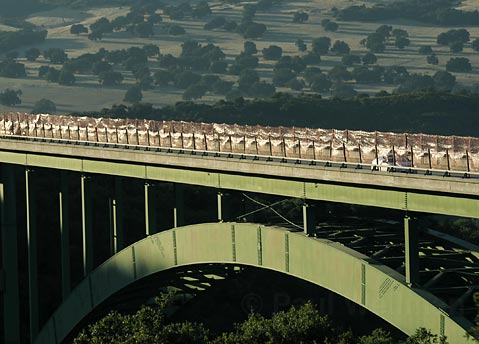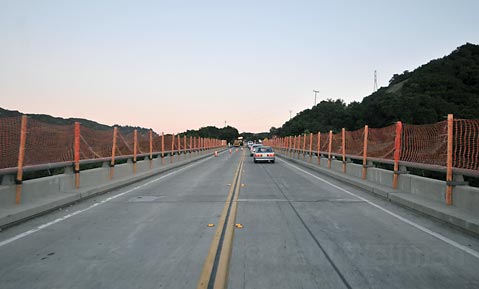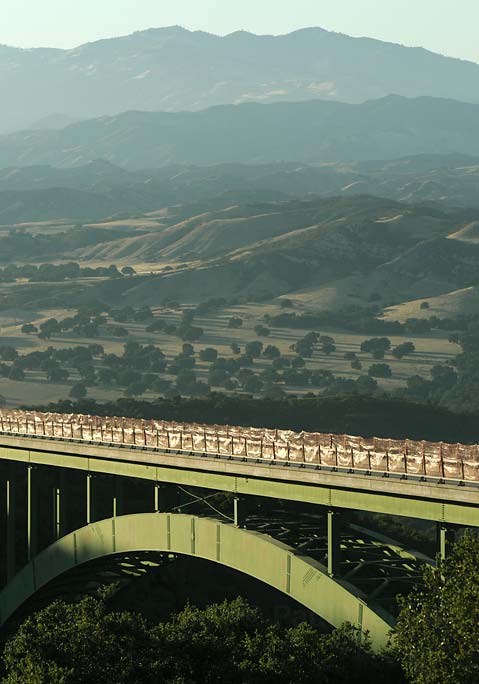Suicide Barrier Hits Stumbling Block
Judge Halts Work on Cold Spring Bridge

Years of protesting, writing op-eds, showing up to public meetings on stilts, walking along Cold Spring Canyon Bridge, trumpet in hand, and other attention-getting antics by retired UCSB professor Marc McGinnes, fueled by his opposition to a suicide barrier on the bridge, often fell upon deaf ears, especially those of elected officials.
Tuesday, finally, someone listened — and that someone was a judge.
Judge Thomas Anderle halted construction of the suicide barrier being built by Caltrans, saying the Environmental Impact Report (EIR) prepared by Caltrans didn’t comply with the California Environmental Quality Act (CEQA).
While the move likely doesn’t mean the end of the project, it is a small victory for McGinnes and his Friends of the Cold Spring Canyon Bridge group after years of being shot down by both local and state officials, who have worked hard and forcefully to get this project through. The judge — while clarifying that he was only ruling on Caltrans’s failure to properly follow CEQA protocol, not whether the barrier should or should not be installed, or if it will be down the line — indicated Caltrans had failed to follow procedural requirements by not including mitigation measures to reduce impacts of the bridge until after the public was able to comment on the measures; the measures weren’t introduced until the final EIR stage rather than the draft EIR stage. It was a basic point of environmental law, but still a point missed by Caltrans and other officials, which means Caltrans has to step back a few squares.

Per Anderle, the state transportation division must prepare, circulate, and certify an EIR — expected to look a lot like the current one — that complies with CEQA, allowing the public to see it, review it, and comment on everything (mitigation measures included) before the project moves forward. “The judge validated our concern that Caltrans had taken on a process that excluded the public from environmental review,” said Marc Chytilo, attorney for Friends of the Bridge.
The highly controversial project was to erect a wire-fence barrier nearly 10 feet high on both sides of the bridge on Highway 154. The bridge has been the site of 53 suicide jumps since it was built in 1963.
Construction on the project — which has been in the works for four or so years — began a few weeks ago and was expected to be done in September. The cost of the actual construction was slated to be roughly $778,000, part of a total $3-million price tag. The stalled construction is expected to cost Caltrans even more money, as are the legal costs.
The price tag was just one reason opponents like Friends of the Bridge, led by their fearless — and often goofy-acting, but persistent — leader McGinnes, sprang to action. The other was the belief that the barrier really wouldn’t do much to deter those who wanted to commit suicide. Chytilo took the occasion of the court hearing to point to a recent study in Toronto after a barrier was installed at a bridge there, the site of the world’s second-highest rate of suicide by jumping, only behind San Francisco’s Golden Gate Bridge. The rate of suicides by jumping in Toronto as a whole remained unchanged, though they did go down at that particular bridge. The study concluded barriers “may not alter absolute rates of suicides.”

McGinnes said he is hopeful that the Santa Barbara County Association of Governments (SBCAG), a board that gave the project its blessing and comprises the five county supervisors and a representative from each county jurisdiction, will take another look at the project and allow for an alternative to the barrier — higher, four-foot-tall guard rails, a call box, closed circuit cameras, an interactive PA system, and a net — which he believes is a more viable option. Regardless of what SBCAG members decide to do, and it’s unlikely they’ll do anything different outside the EIR issue, it is ultimately Caltrans’s call for what happens on the bridge, though SBCAG has put a lot of money toward the project. That money could be better spent, argues McGinnes, on other dangerous highway spots in the county.
So now Caltrans heads back to the drawing board, sort of. Though they believe they fulfilled all CEQA requirements, they’re suspending construction while they reproduce and recirculate a small portion of the environmental document, according to spokesman Jim Shivers, though it’s unclear what state the bridge — already under construction — will be left in. The plan is to return to court on August 24, at which time Caltrans is hopeful they get the go-ahead to continue work on the bridge. “We are confident that we will meet the additional requirements of the court which will allow Caltrans to resume work and complete this project, which will prevent suicides on the bridge,” he said.


